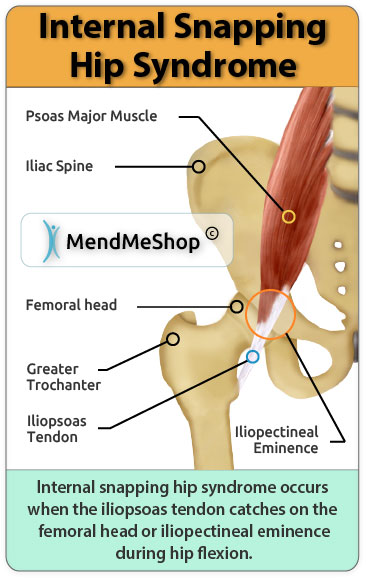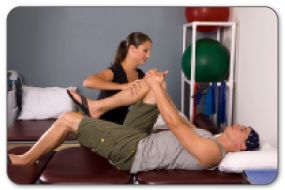Snapping hip syndrome is identified as a snapping or clicking sensation (and possible sound) in the hip joint that may or may not cause pain. The hip may also feel unstable and may give a sensation like your hip will give out. In most cases, the condition is more of an annoyance than anything serious but repeated snapping or popping may induce worsening pain, irritation and damage in the iliopsoas tendon. There is greater risk of an occurrence of bursitis due to snapping hip syndrome.
Snapping hip syndrome occurs when a tendon running along the front or side of the hip flexor pops or snaps over a bone. This occurs when the leg moves from flexion to extension with the iliopsoas, or hip flexor, muscle. Snapping hip syndrome can be divided into different types: external, internal or intra-articular, which depend on where the snap is occurring.
This occurrence of snapping hip syndrome and is often referred to as an external clicking hip. It happens when either: (1) the Iliotibial band (IT band) slides over the greater trochanter at the top of the femur, or (2) when the gluteus maximus muscle slides over the greater trochanter. During hip flexion, when the leg moves forward, the gluteus maximus contracts and the tendon or muscle is pulled over the greater trochanter along with the iliotibial tract (IT band). When the gluteus medius tendon or IT band thickens or frays, it is more likely to catch on the bone.
Due to tightness over the trochanteric bursa and irritation in the area, trochanteric bursitis may also develop with this type of snapping hip syndrome. With trochanteric bursitis, pain and tenderness will manifest itself on the outside of the hip. If a person is suffering from external snapping hip, it may also be a sign that the IT band or gluteus maximus muscle is tight - a condition known as IT band syndrome.


This type of snapping hip is considered to be the most common type of snapping hip. It occurs when either (1)the iliopsoas tendon snaps over the iliopectineal eminence (a protrusion of the pelvic bone), or (2) the rectus femoris (one of the main quadriceps muscles) snaps over the femoral head of the hips ball and socket joint.
There is typically a gradual onset of internal snapping hip over a few months before the clicking may become noticeable. Internal snapping hip syndrome may cause or be triggered by iliopsoas bursitis which is a painful bursitis located at the front of the hip joint.
Loose bodies in the hip joint or other tissue catching (such as tissue from a labral tear) can cause intra-articular snapping hip syndrome. This type of syndrome is basically a snapping hip problem due to a cartilage injury.
A snapping hip may be caused by:
The labrum is a unique piece of cartilage that lines the inside of the hip socket. If it becomes damaged or torn, as is the case when an acetabular labral tear occurs, then it can cause a snap or pop in the hip joint itself as it moves. A study* published in 2005 indicates that approximately 80% of Intra-Articular Snapping Hip cases were caused by acetabular labral tear.
*Reference: Yamamoto, Yasuhiro & Hamada, Yoshiki & Ide, Takatoshi & Usui, Ikuo. (2005). Arthroscopic Surgery to Treat Intra-articular Type Snapping Hip. Arthroscopy : the journal of arthroscopic & related surgery : official publication of the Arthroscopy Association of North America and the International Arthroscopy Association. 21. 1120-5. 10.1016/j.arthro.2005.05.021.
The treatment for snapping hip syndrome should focus on resting your hip and reducing inflammation to relieve pain.

PT can assist you in stretching the gluteus maximus tendon and IT band if they are tight. If the gluteus maximus tendon or iliotibial tract have thickened, frayed and/or become inflamed you can treat the injury with conservative treatment methods to work on the tough connective tissue such as tendons, muscles and ligaments. Once swelling is reduced with application of a Cold Compress or Ice Pack, treating the area with a Back/Hip TShellz Wrap® will help induce an increase in blood flow while also temporarily increasing the flexibility of soft tissue in the area. This should help alleviate the symptoms of snapping hip fairly quickly. In most cases, utilizing home conservative treatments such as a Cold Compress or Ice Pack and the TShellz Wrap®, combined with rest and a stretching regimen will help or -at minimum- reduce the severity of snapping hip syndrome.
Conservative treatment therapies such as cold compression and the use of the Back/Hip TShellz Wrap® will help keep hip joint tissue and surrounding muscles as healthy as possible preceding surgery. This is beneficial for 2 reasons. First, with less inflammation and healthier tissue in the joint, your surgery will be less invasive (due to less inflammation and irritation) and will require less time to heal. More importantly, it will minimize your risk of suffering future hip conditions such as osteoarthritis, chronic hip pain, and trochanteric bursitis (which is a common condition immediately following surgery due to irritation during the procedure). Following your surgery, continued use of recommended conservative treatment recovery protocols (assigned by your surgeon) will result in a faster bounceback from surgery and help you recover more completely. The use of home conservative treatment options is, in our opinion, beneficial both before and after arthroscopic surgery.
To decrease inflammation and relieve the pain of snapping hip syndrome doctors recommend the application of cold and compression. Cold within the first 72 hours of injury to the tendon or labrum or following surgery is an effective way to relieve pain and swelling. Cold will also limit the amount of damage done to your tissue and can reduce, or even eliminate, the need for NSAIDs that can be harmful to your body.
Cold compression works by interrupting and slowing nerve and tissue function in soft tissue in the hip joint. It also reduces swelling that can block blood vessels. This is important because once blood vessels are blocked or damaged, they can no longer carry oxygen and nutrients to the tissue in your hip joint and the cells begin to break-down. Without cold compression, damage continues as tissues break-down - they cannot get the oxygen they need to survive.
By limiting the amount of damage done to your tissue, you limit the amount of healing that needs to occur. This is a very important step to heal your hip faster and with less pain!
After severe inflammation and swelling is reduced, it is time to take the next step in your soft tissue treatment. Use a Back/Hip TShellz Wrap® to improve blood flow while simultaneously helping surrounding soft tissue to become elongated and more elastic. Elongated and more flexible soft tissue means snapping will reduce in most cases (ie. snapping hip due to tight IT band, etc). In our opinion, the TShellz Wrap® is the perfect home treatment - helping increase flexibility while simultaneously boosting the body's natural healing ability due to increased blood flow.
In addition, the improved blood flow obtained by using the TShellz Wrap helps reduce the risk of atrophy in your muscles. When you stop moving your leg and hip due to pain, your muscles and other tissue become weaker, and dead tissue and toxins in the area build up due to lack of circulation. This can cause further tissue deterioration and lead to atrophy in your quadriceps, hamstrings and other leg muscles. By clearing the area of toxins and increasing the amount of oxygen and nutrients to your labrum and other tissue, the risk of atrophy(muscle weakness and/or deterioration) is reduced.
Keeping your upper leg and hip joint tissue as healthy and limber as possible throughout the healing process will allow you to improve hip strength again once your pain has gone and your recovery is well underway.
PT is a beneficial way to restore atrophied muscles and improve strength and mobility after significant periods of reduced mobility (usually due to a soft tissue tear or injury). The type of PT and the duration will be dependent on the tissue damage and your symptoms. When you are treating or recovering from atrophy or tears or strains in muscles, tendons or ligaments, it is important to adhere to the instructions of the physical therapist to ensure you are doing exercises properly and not under-doing it or overdoing it, as this will increase your risk of soft tissue re-injury.

Once pain starts to diminish, a physiotherapist will usually set up an individualized strengthening and stretching exercise program for you to perform at home or in the gym. This will be based on your needs and abilities, and will help you return to performing your normal routines.
Individuals will often lift weights on their own, to try and build up their strength. However, in doing so, they can do more damage to their joint. It is extremely important to strengthen your muscles properly, as they may have weakened during the period of non-use. A trained therapist will help to ensure your rehabilitation process is appropriate and effective. For best, long term results use TShellz Wraps® at home, in conjunction with PT and an exercise program.
Click HERE to Go To Our Online Store We take all major credit cards and Paypal.
If you have questions, call our office at 1-866-237-9608 (toll free continental US).
We are currently offering FREE SHIPPING and a 60 day trial period on all our Wraps.
Product Advisors are available 9:00 am to 5:00 pm Eastern Standard Time Monday to Friday.
I want to learn more about Hip Surgery & Post-Surgery Recovery
I want to learn more about Circulation Boost
I want to learn more about Ice & Heat: Which Is Better For The Hip?
I want to learn more about Trigger Points in the Hip
I want to learn more about Hip Surgery: Do I Need It?
During your recovery, you will probably have to modify and/or eliminate any activities that cause pain or discomfort at the location of your soft tissue injury until the pain and inflammation settle. The more diligent you are with your treatment and rehabilitation, the faster you will see successful results!
Please be aware that this information is neither intended nor implied to be a substitute for professional medical advice. CALL YOUR HEALTHCARE PROVIDER IMMEDIATELY IF YOU THINK YOU MAY HAVE A MEDICAL EMERGENCY. Always seek the advice of your physician or other qualified health provider before using any of our outstanding products to make sure they are right for you and your condition or if you have any questions regarding a medical condition. Always see your doctor for a proper diagnosis as there are often many injuries and conditions (some very serious) that could be the cause of your pain.
© 2025 In.Genu Design Group, Inc. Contact Us